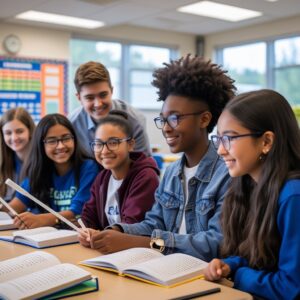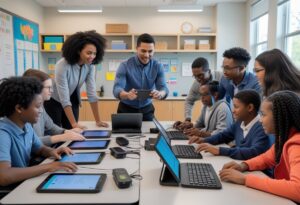Innovations in Assistive Technology for Deaf-Blind Individuals

Enhancing Communication and Independence
Innovative technology is changing the landscape for those who are deaf-blind, paving the way for greater communication and independence. We at New England Low Vision and Blindness are passionate about providing leading-edge solutions that empower individuals to navigate their environments with confidence. In the pursuit of accessibility, new tools are being developed to bridge communication gaps and foster independence.
Leading-Edge Solutions for Enhanced Communication
Technological advancements, such as wearable devices and AI-powered platforms, are making communication more accessible for the deaf-blind community. Devices like the Sunu Band provide haptic feedback to alert users to obstacles, enhancing daily navigation. Additionally, AI applications like BridgeAI are using deep learning to improve communication by translating sign language into text or speech. This progress not only delivers practical benefits but also brings us closer to a world where accessibility is the norm.
As we continue to explore these innovations, we are committed to supporting individuals in achieving greater autonomy and interaction with the world around them. Our mission at New England Low Vision and Blindness is to keep our community informed about the latest technologies that transform lives.
Discover NuCaption: Real-Time Solutions for the Deaf-Blind Community
 Empower communication with NuCaption, the innovative tool designed specifically for the Deaf-Blind community. This real-time captioning solution transforms the way individuals interact with the world, providing clear, accessible, and immediate text translation during conversations. Whether you’re at a meeting, in class, or enjoying social events, NuCaption bridges the gap and fosters inclusive environments.
Empower communication with NuCaption, the innovative tool designed specifically for the Deaf-Blind community. This real-time captioning solution transforms the way individuals interact with the world, providing clear, accessible, and immediate text translation during conversations. Whether you’re at a meeting, in class, or enjoying social events, NuCaption bridges the gap and fosters inclusive environments.
Learn more and explore how NuCaption can transform your experience today. Visit our product page NuCaption – Real-Time Solutions for the Deaf-Blind Community or watch our video.
Understanding Deaf-Blindness
Deaf blindness is a unique sensory disability that combines vision and hearing impairments, creating significant challenges in communication and daily life. Through effective solutions and adaptive technologies, we strive to support independence and accessibility.
Defining Deaf-Blindness and Its Challenges
Deafblindness involves a dual sensory disability where individuals face both hearing and vision impairments. This presents complex challenges, as traditional communication methods often rely heavily on these senses. Adaptive strategies are crucial for enabling effective interaction.
Individuals may experience varying degrees of hearing impairment and vision loss. This diversity requires personalized approaches to support. Developing tactile communication methods, like tactile sign language, helps bridge communication gaps for those affected by deaf-blindness.
Effective assistive technology is essential to overcome these obstacles and facilitate engagement and participation.
The Importance of Accessibility in Daily Living
Accessibility plays a pivotal role in the lives of individuals with deaf-blindness. Leading-edge technologies and assistive solutions can make a significant impact. Through comprehensive training and support, we can empower individuals to achieve greater independence.
Innovative tools like tactile sign language apps and touch-based devices enhance communication and interaction. Customized accessibility solutions are vital for tackling diverse challenges encountered in daily activities.
At New England Low Vision and Blindness, we focus on providing life-changing resources that foster empowerment and autonomy for those affected by sensory disabilities. Our commitment to support ensures that everyone has the opportunity to live more independently.
Advancements in Communication Technologies
As we explore the leading-edge innovations transforming communication for Deaf-Blind individuals, several areas of technological advancement stand out. From specialized communication devices to developments in text-to-speech and braille technology, these advancements empower independence and enrich personal and professional interactions.
Innovative Communication Devices and Apps
We are witnessing remarkable strides in communication devices designed specifically for Deaf-Blind individuals. These devices often combine multiple functionalities to cater to diverse needs. Some devices use haptic feedback and vibration alerts to deliver messages silently.
Apps with tactile sign language capabilities play a crucial role by bridging communication gaps. They offer users a way to communicate effectively without relying solely on auditory or visual cues. By focusing on sensory inputs unique to each individual, these innovations create more inclusive environments.
Text-to-Speech and Speech Recognition Developments
Text-to-speech technology has significantly evolved, providing Deaf-Blind individuals with new ways to understand spoken language. These systems can convert text into natural-sounding speech, enhancing accessibility in various settings.
Speech recognition technology complements this by enabling voice commands and transcriptions. This dual approach allows users to engage interactively with their devices and surroundings. These advancements support greater independence, facilitating smoother interactions in both social and work scenarios.
Braille Technology and Tactile Communication Devices
Braille technology continues to be a cornerstone in accessibility for the Deaf-Blind community. Braille displays and notetakers have become more portable, with improved refresh rates, enabling faster and more efficient reading of digital text.
In addition to braille, tactile communication devices are being developed to translate text into tactile feedback, allowing users to “feel” the messages. Such devices make everyday communication more accessible and open up new possibilities for personal expression. With these innovations, we strive to enhance the quality of life for those who are visually and hearing impaired, providing adaptable tools tailored to their unique needs.
Emerging Technologies in Navigational Aids
Navigational aids are revolutionizing how individuals with visual impairments and those who are deaf-blind navigate the world. From GPS-integrated smartphones to wearable technology, these advancements offer enhanced mobility and independence.
GPS and Smart Mobility Solutions
GPS technology plays a crucial role in providing real-time navigation support. Our focus is on integrating this versatile tool into compact, user-friendly devices. Position Locator Devices, for instance, use GPS to help users pinpoint their exact location, offering vital data for navigating unfamiliar spaces. These devices can be easily paired with smartphones or other portable gadgets, bringing navigation assistance within reach of most individuals.
Mobile apps leveraging GPS make travel safer and more efficient. By providing audio-based instructions, users can receive turn-by-turn directions seamlessly. These systems can also incorporate public transport schedules and alert the user to obstacles, ensuring a fluid travel experience through both known and unfamiliar environments.
Smart Glasses and Augmented Reality for Enhanced Perception
Smart glasses equipped with augmented reality (AR) and haptic feedback enable a dynamic navigational experience. By overlaying digital information on physical environments, smart glasses can transform how individuals perceive their surroundings. This technology provides spatial awareness by visually enhancing or audibly describing important aspects of the environment.
With advancements in computer vision, these glasses identify obstacles and offer vibration or audio alerts, increasing safety for users. The combination of AR with traditional aids, like white canes, empowers greater movement autonomy. Our commitment is to make these leading-edge solutions accessible, helping improve the day-to-day autonomy and confidence of people with visual impairments.
Educational Tools for Deaf-Blind Learners
Exploring assistive devices and tactile learning resources is fundamental in empowering deaf-blind individuals in their educational journey. These tools facilitate engagement and understanding, enhancing access to information and improving communication.
Assistive Devices in Classroom Settings
In classroom settings, assistive devices play a crucial role in supporting deaf-blind students. Braille technology, such as Braille note-takers and embossers, provides tactile access to written content. Devices like refreshable braille displays are essential for real-time reading and content manipulation.
Screen readers convert text to speech or Braille, allowing learners to interact with digital content. These devices integrate with other technologies, offering dynamic learning experiences. It’s vital to tailor the selection of tools to each student’s unique needs, ensuring they receive the appropriate level of support and interaction.
New England Low Vision and Blindness is committed to delivering these leading-edge solutions to enhance educational outcomes. As leading providers, we offer personalized training, ensuring that both educators and students feel equipped and confident.
Tactile Graphics and Learning Resources
Tactile graphics provide a multisensory learning approach, crucial for conveying complex concepts. These graphics are created using raised lines and textures, enabling students to explore diagrams and maps through touch.
Incorporating tactile learning resources into the curriculum enhances comprehension, particularly in subjects like math and science. Partnering tactile resources with audio descriptions or braille labels can significantly improve the learning experience.
We understand the importance of blending these tools effectively into lesson plans, ensuring students enjoy a cohesive and inclusive learning environment. Our expertise in providing these resources reinforces our commitment to empowering every deaf-blind learner, fostering an inclusive educational landscape. New England Low Vision and Blindness strives to continuously support this essential work.
Integration of Assistive Technology into Daily Life
Incorporating assistive technologies into daily living can significantly enhance independence for deaf-blind individuals. With the help of smart home systems and healthcare professionals, technology offers unprecedented support and empowerment.
Smart Home Devices and Independent Living
Smart home devices greatly contribute to the independence of those who are deaf-blind. These devices can automate lighting, security, and temperature control, allowing users to manage their environment with greater autonomy. Smartphones and wearable devices further enhance this experience by providing video relay services and notifications in accessible formats. For instance, a vibration alert on a wearable device can signal the doorbell or a smart smoke detector. Such features empower individuals to navigate their daily routines with ease and confidence, enhancing quality of life.
The Role of Healthcare Professionals in Technology Adoption
Healthcare professionals play a pivotal role in the adoption of assistive technology. They guide users through personalized training sessions, ensuring devices are tailored to individual needs. Our team at New England Low Vision and Blindness works closely with users to address specific challenges they may face. By collaborating with technology experts, healthcare providers can integrate leading-edge assistive technologies into care plans, maximizing their effectiveness. Support from professionals ensures that users receive comprehensive guidance, helping them fully utilize devices to enhance their independence.
The Future of Assistive Technology
The future of assistive technology promises game-changing advancements, especially in integrating AI and machine learning. Equally crucial is fostering advocacy and inclusivity, ensuring these advancements enhance accessibility for everyone in the deaf-blind community.
Artificial Intelligence and Machine Learning Applications
Artificial Intelligence is revolutionizing assistive technology by enabling devices to perform tasks that once seemed insurmountable. Applications range from AI-powered real-time captioning to haptic feedback systems. These systems translate auditory and visual information into tactile responses. Machine learning enhances these technologies, allowing devices to learn and adapt based on user interaction.
Virtual reality and other immersive technologies are also gaining traction. They offer ways to convey complex visual and auditory information in more accessible formats. Our commitment to incorporating such innovations ensures the visually impaired community has access to leading-edge solutions. Explore more on the future of assistive devices benefiting the deaf-blind.
The Importance of Advocacy and Inclusivity in Technology Development
Advocacy is instrumental in driving change, pushing for technology that truly serves its users. By involving the deaf-blind community in development, we can create tools that accurately address their needs. Inclusivity ensures these solutions are not just theoretical improvements but practical enhancements to daily life.
Collaboration with users leads to personalized solutions, reflecting the diverse needs within the community. Funding and policy initiatives should prioritize inclusive design and development. Our role in New England Low Vision and Blindness is to advance such discussions, ensuring these cutting-edge solutions reflect the real-world needs of our users. Learn more about the importance of advocacy in accessibility for a more inclusive future.
Frequently Asked Questions
In this section, we address key topics around assistive technology for those who are deaf-blind. We examine recent innovations, educational support, communication aids, life enhancements, wearable tech advancements, and access resources.
What are some recent advancements in assistive technology for individuals who are deaf-blind?
Recent innovations offer transformative experiences. Among the technologies, artificial intelligence and tactile feedback have greatly improved communication and navigation tools. We focus on providing these leading-edge solutions to enhance independence.
How can assistive technology support educational outcomes for deaf-blind students?
Assistive tools foster educational success by enabling effective communication and learning. Devices tailor content for multi-sensory learning, enhancing engagement. Our training ensures students can leverage these tools fully, empowering their academic journey.
What types of devices are currently available to aid deaf-blind people in communication?
Communication tools such as tactile sign language apps and braille displays improve interaction with the world. These innovations help bridge communication gaps, supporting greater connectivity.
Which assistive technologies are most effective for improving daily living for deaf-blind individuals?
Daily life enhancements come through devices like self-guided mobility aids. These tools promote independence by assisting with navigation and everyday tasks, which is crucial for self-sufficiency.
Are there any new developments in wearable technology for those with both hearing and vision impairments?
Wearable technology has seen major advancements, providing users with sensory experiences and communication options. We continually explore the latest developments to incorporate into our offerings, improving our support for daily activities.
What resources provide access to free or subsidized assistive equipment for the deaf-blind community?
Vocational rehabilitation agencies and state programs may offer free or subsidized equipment. For example, some states provide adaptive telecommunications equipment for eligible individuals, ensuring wider access to these necessary technologies.
Experience Empowerment with Our Deaf-Blind Training
Unlock independence and enhance accessibility with our specialized Deaf-Blind Training services. Whether you’re an individual seeking tailored solutions, an organization striving to create inclusive environments, or a caregiver aiming to support loved ones, our training is designed to provide practical tools and strategies.
👉 Learn More & Get Started Today
Discover NuCaption: Real-Time Solutions for the Deaf-Blind Community
 Empower communication with NuCaption, the innovative tool designed specifically for the Deaf-Blind community. This real-time captioning solution transforms the way individuals interact with the world, providing clear, accessible, and immediate text translation during conversations. Whether you’re at a meeting, in class, or enjoying social events, NuCaption bridges the gap and fosters inclusive environments.
Empower communication with NuCaption, the innovative tool designed specifically for the Deaf-Blind community. This real-time captioning solution transforms the way individuals interact with the world, providing clear, accessible, and immediate text translation during conversations. Whether you’re at a meeting, in class, or enjoying social events, NuCaption bridges the gap and fosters inclusive environments.
Learn more and explore how NuCaption can transform your experience today. Visit our product page NuCaption – Real-Time Solutions for the Deaf-Blind Community or watch our video.



